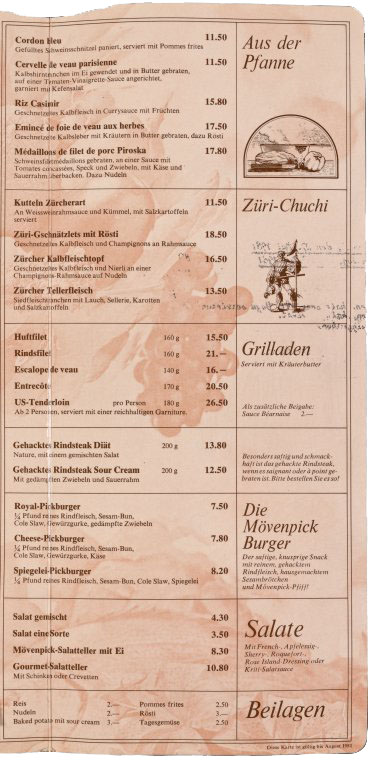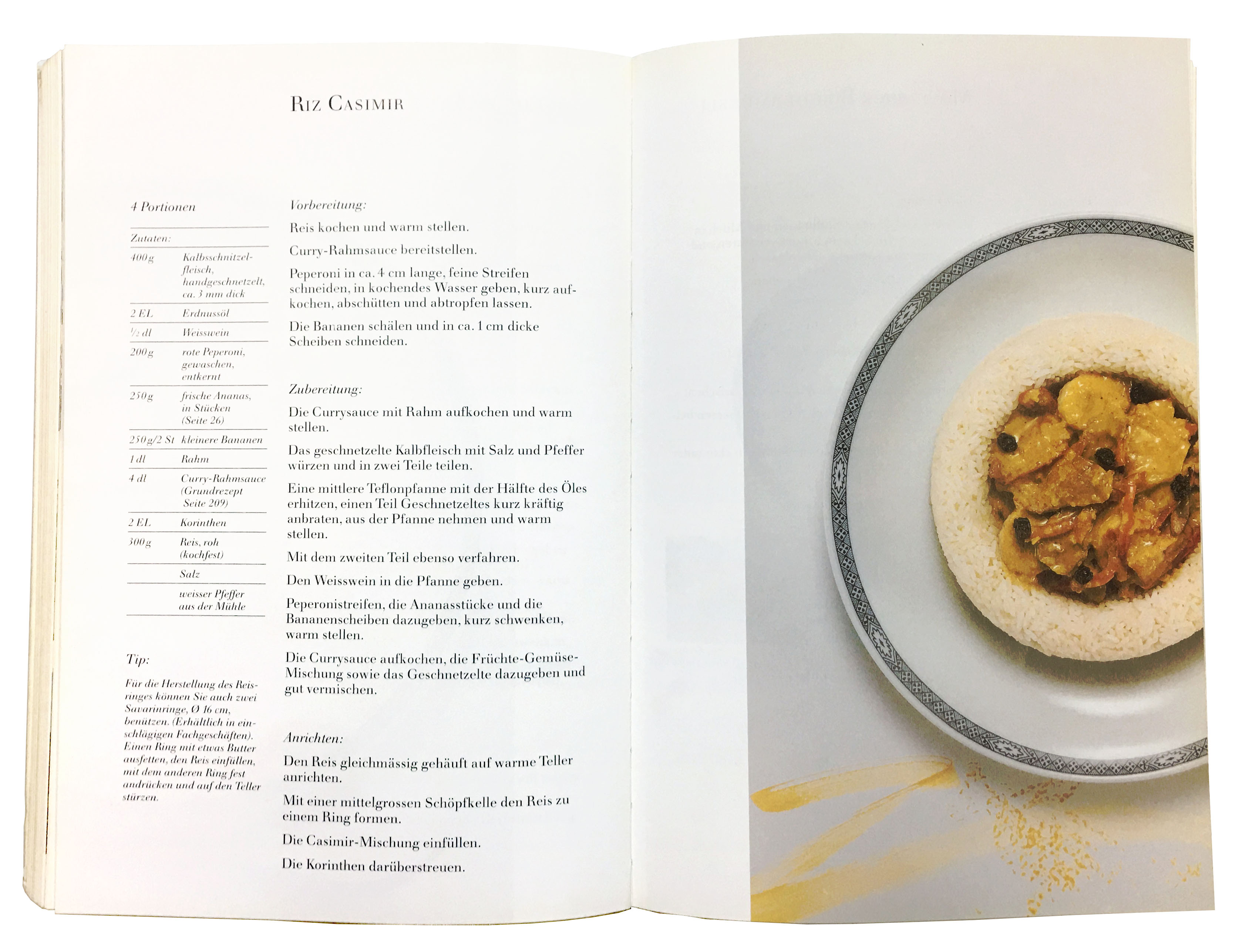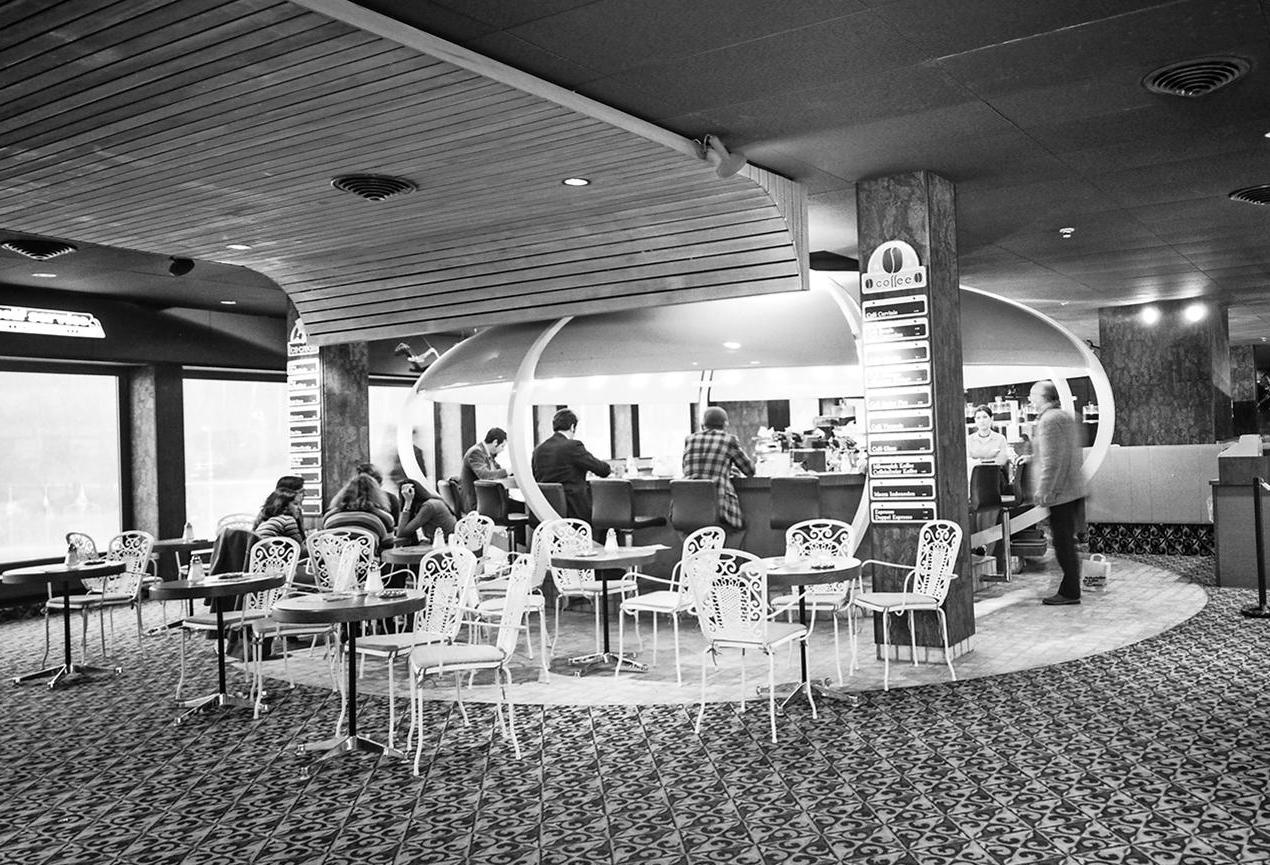
2 - menu
Ueli Pragers Mövenpick menu

1 - original recipe Riz Casimir
Ueli Pragers Mövenpick Story

2 - menu

3 - Riz Casimir

4 - supermarked
1 portion rice
1 portion curry sauce:
cream and 2 spoons of curry powder
400g veal or poultry meat
a bit of butter
1-2 bananas
4 slices of pineapple
4 peach halves
some red cherries
almond sticks
According to the Swiss school classic «Tiptopf» this is what the «national dish» Riz Casimir is made of. (1) In 1952, the dish with the exotic name appeared on the menu of the famous restaurant Mövenpick in Zurich. It soon made its way to all Swiss households and still widely cooked in school camps, elderly homes and the military.
What sounds like a simple invention was only possible thanks to major changes in the Swiss food market. The economic miracle after the Second World War brought not only cars, televisions and new hairstyles, but also a new kitchen. Electric ovens, microwaves or refrigerators introduced new domestic and also industrial processes that opened up new culinary possibilities. The new optimism fueled the lust for consumption. Thanks to capitalism, social benefits and rising real wages the prosperity of the Swiss Confederation was growing and so did the middle class. (2) After the long years of war, this new middle class was longing for something they could consider a luxury. With this new attitude and the financial power going to a restaurant became feasible for more and more people and the restaurant turned into a place for the people to live out their cosmopolitan yearnings for modernity. Mövenpick tried to pick up on that vibe. «Exotic» is the definition for luxury at that time, which paves the way for the break-through of Riz Casimir. It meets all the criteria of modern flair: The name, reminiscent of cashmere and its ingredients freshly out of the can from lands far away, show «sophisticated cosmopolitanism». (3) Also the consumption of the expensive meat of veal, after the meatless years of war, is a symbol of status. Topped of with cream, it adds a familiar Swiss taste to the luxurious creation of Riz Casimir.
Ideally, the postwar bourgeoise housewife had a lot of time to spend for elaborate cooking to satisfy exotic cravings. With the growing wages this ideal also reaches parts of society were the housewife did not exist before. Women are playing all of the roles: they are housewives, mothers, wives, cooks and also workers. But this ideal is hardly reality. As women are working and also throwing the household, the expectations are high - especially if the postwar husband insists on special food. This is a clear advantage of Riz Casimir, as time is limited, the dish benefits from modes of preparation between 20 minutes to 2 hours, while still staying more or less the same. Its quality is in its recognizability: Cherries, cream, parsley, rice arranged in a ring and the characteristic yellow creamy sauce. Rice and fruits preferably come out of the can - practical and modern. The dish is adaptable, to time and prices. All of these lead to the fame of the Swiss classic. (4)
But that Riz Casimir could conquer all households is also due to major infrastructural works that had to be made to cover the country with a net of supermarkets, providing universal availability of foods. Until the 40s still Zurich’s menu was characterized by seasonal vegetables probably from one's own garden, lots of potatoes, little meat and little fruits. With the arrival of the mobile grocery store the gardens on the outskirts of Zurich started to lose their nutritional meaning making space for easily maintainable lawns. With time and growth of the settlements and the economy, the trucks turned into supermarkets introducing completely new foods to the diet of the people. Riz Casimir consists of Swiss classics but the «fruit cocktail», made of pineapple and bananas out of the can drastically changed the Swiss food system. The bananas, coming once a week from large plantations overseas, demanded for a large banana ripening plant in the country. The rice was not grown in Switzerland either, but was processed in a local rice mill. The dish is an example for commodification that made new forms of food widely accessible, detaching eating habits from seasonality and locality.
The appearance of Riz Casimir, activating soil and labour in lands far away, was the beginning of a globalized system of food. At that time, the further it travelled the higher the cosmopolitan vibe was. Today, Riz Casimir, is still the favorite dish of people in elder homes who grew up in a time of economic opening, that introduced supermarkets, that are now considered so normal that nobody would know what to eat without them. The system is running smoothly - and its growing. We are speculating that dishes that now appear in cookbooks like «Alltagsküche der Schweiz» that try to re-interpret books like «Tiptopf» referring to them in a slightly humorous way, are basically still the same at core. A Buddha Bowl (interestingly also proudly available in canines of universities and schools) is nothing else than Riz Casimir, with products that might even have a more drastic impact on our environment and are much more globalized as the are not solely a «Swiss» craving.
A dish on a menu can lead to drastic changes. It is about the thousands of dishes eaten by thousands of people that lead to supply chains bigger that one can imagine. That we can suddenly eat a new things, is thanks to immense infrastructures, millions of hands and exploitative systems.
Riz Casimir exemplifies a shift ranging from the everyday of cooking at home to how we treat the environment, probably there are many more dishes in many countries that tell similar stories. The change of lifestyle, the way kitchens are designed, housing is developed, supermarkets expand and resources are exploited, can be traced within that one dish.
Today 80% of the people in Zurich, buy their food at a supermarket and with an exhaustive net, where a supermarket is always just around 5 minutes away from wherever you are, this is also not a big surprise. As resources are limited and we are confronted with more and more environmental and social issues today, the postwar optimism and belief in endless progress has to be questioned.

2 - menu
Ueli Pragers Mövenpick menu

1 - original recipe Riz Casimir
Ueli Pragers Mövenpick Story

2 - menu

3 - Riz Casimir

4 - supermarked